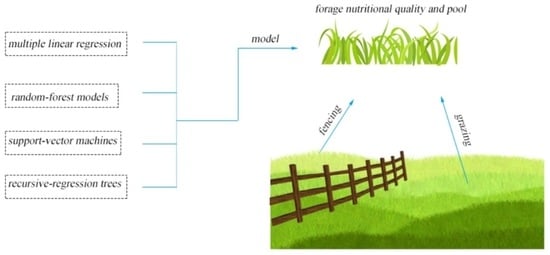Modeling Nutrition Quality and Storage of Forage Using Climate Data and Normalized-Difference Vegetation Index in Alpine Grasslands
Abstract
:1. Introduction
2. Materials and Methods
2.1. Plant Sampling and Analyses
2.2. Normalized-Difference Vegetation Index and Climate Data
2.3. Statistical Analysis
3. Results
3.1. Model Building
3.2. Model Validation
4. Discussion
5. Conclusions
Author Contributions
Funding
Data Availability Statement
Acknowledgments
Conflicts of Interest
References
- Fu, G.; Wang, J.; Li, S.; He, P. Responses of forage nutrient quality to grazing in the alpine grassland of Northern Tibet. Acta Prataculturae Sin. 2021, 30, 38–50. [Google Scholar]
- Wang, X.; Liu, S.-J.; Jia, H.-F.; Chai, S.-T.; Dang, A.-R.; Liu, X.-H.; Hao, L.-Z.; Cui, Z.-H. Study on the Nutrition of Alpine Meadow Based on Hyperspectral Data. Spectrosc. Spectr. Anal. 2012, 32, 2780–2784. [Google Scholar] [CrossRef]
- Craine, J.M.; Elmore, A.; Angerer, J.P. Long-term declines in dietary nutritional quality for North American cattle. Environ. Res. Lett. 2017, 12, 044019. [Google Scholar] [CrossRef] [Green Version]
- Sun, W.; Li, S.; Zhang, Y.; Fu, G. Effect of long-term experimental warming on the nutritional quality of alpine meadows in the Northern Tibet. J. Resour. Ecol. 2020, 11, 516–524. [Google Scholar]
- Fanselow, N.; Schonbach, P.; Gong, X.Y.; Lin, S.; Taube, F.; Loges, R.; Pan, Q.M.; Dittert, K. Short-term regrowth responses of four steppe grassland species to grazing intensity, water and nitrogen in Inner Mongolia. Plant Soil 2011, 340, 279–289. [Google Scholar] [CrossRef]
- Dale, L.M.; Pierna, J.A.F.; Vermeulen, P.; Lecler, B.; Bogdan, A.D.; Pacurar, F.S.; Rotar, I.; Thewis, A.; Baeten, V. Research on crude protein and digestibility of Arnica montana L. using conventional NIR spectrometry and hyperspectral imaging NIR. J. Food Agric. Environ. 2012, 10, 391–396. [Google Scholar]
- Zengeya, F.M.; Mutanga, O.; Murwira, A. Linking remotely sensed forage quality estimates from WorldView-2 multispectral data with cattle distribution in a savanna landscape. Int. J. Appl. Earth Obs. Geoinf. 2013, 21, 513–524. [Google Scholar] [CrossRef]
- Hogrefe, K.R.; Patil, V.P.; Ruthrauff, D.R.; Meixell, B.W.; Budde, M.E.; Hupp, J.W.; Ward, D.H. Normalized difference vegetation index as an estimator for abundance and quality of Avian herbivore forage in Arctic Alaska. Remote Sens. 2017, 9, 1234. [Google Scholar] [CrossRef] [Green Version]
- Thoma, D.P.; Bailey, D.W.; Long, D.S.; Nielsen, G.A.; Henry, M.P.; Breneman, M.C.; Montagne, C. Short-term monitoring of rangeland forage conditions with AVHRR imagery. J. Range Manag. 2002, 55, 383–389. [Google Scholar] [CrossRef]
- Beeri, O.; Phillips, R.; Hendrickson, J.; Frank, A.B.; Kronberg, S. Estimating forage quantity and quality using aerial hyperspectral imagery for northern mixed-grass prairie. Remote Sens. Environ. 2007, 110, 216–225. [Google Scholar] [CrossRef]
- Sun, W.; Li, M.; Wang, J.H.; Fu, G. Driving mechanism of gross primary production changes and implications for grassland management on the Tibetan Plateau. J. Resour. Ecol. 2019, 10, 472–480. [Google Scholar]
- Wang, J.; Li, M.; Yu, C.; Fu, G. The change in environmental variables linked to climate change has a stronger effect on aboveground net primary productivity than does phenological change in alpine grasslands. Front. Plant Sci. 2022, 12, 798633. [Google Scholar] [CrossRef] [PubMed]
- Kawamura, K.; Akiyama, T.; Yokota, H.; Tsutsumi, M.; Yasuda, T.; Watanabe, O.; Wang, G.; Wang, S. Monitoring of forage conditions with MODIS imagery in the Xilingol steppe, Inner Mongolia. Int. J. Remote Sens. 2005, 26, 1423–1436. [Google Scholar] [CrossRef]
- Knox, N.M.; Skidmore, A.K.; Prins, H.H.T.; Heitkonig, I.M.A.; Slotow, R.; van der Waal, C.; de Boer, W.F. Remote sensing of forage nutrients: Combining ecological and spectral absorption feature data. Isprs J. Photogramm. Remote Sens. 2012, 72, 27–35. [Google Scholar] [CrossRef]
- Ren, H.Y.; Han, G.D.; Schonbach, P.; Gierus, M.; Taube, F. Forage nutritional characteristics and yield dynamics in a grazed semiarid steppe ecosystem of Inner Mongolia, China. Ecol. Indic. 2016, 60, 460–469. [Google Scholar] [CrossRef]
- Sasaki, T.; Ohkuro, T.; Jamsran, U.; Takeuchi, K. Changes in the herbage nutritive value and yield associated with threshold responses of vegetation to grazing in Mongolian rangelands. Grass Forage Sci. 2012, 67, 446–455. [Google Scholar] [CrossRef]
- Fu, G.; Sun, W. Temperature sensitivities of vegetation indices and aboveground biomass are primarily linked with warming magnitude in high-cold grasslands. Sci. Total Environ. 2022, 843. [Google Scholar] [CrossRef]
- Shen, Z.X.; Fu, G.; Yu, C.Q.; Sun, W.; Zhang, X.Z. Relationship between the growing season maximum enhanced vegetation index and climatic factors on the Tibetan Plateau. Remote Sens. 2014, 6, 6765–6789. [Google Scholar] [CrossRef] [Green Version]
- Wang, S.H.; Sun, W.; Li, S.W.; Shen, Z.X.; Fu, G. Interannual variation of the growing season maximum normalized difference vegetation index, MNDVI, and its relationship with climatic factors on the Tibetan Plateau. Pol. J. Ecol. 2015, 63, 424–439. [Google Scholar] [CrossRef]
- Zhang, G.; Shen, Z.; Fu, G. Function diversity of soil fungal community has little exclusive effects on the response of aboveground plant production to experimental warming in alpine grasslands. Appl. Soil Ecol. 2021, 168, 104153. [Google Scholar] [CrossRef]
- Fu, G.; Zhang, H.R.; Sun, W. Response of plant production to growing/non-growing season asymmetric warming in an alpine meadow of the Northern Tibetan Plateau. Sci. Total Environ. 2019, 650, 2666–2673. [Google Scholar] [CrossRef] [PubMed]
- Wang, J.W.; Fu, G.; Zhang, G.Y.; Shen, Z.X. The effect of higher warming on vegetation indices and biomass production is dampened by greater drying in an alpine meadow on the Northern Tibetan Plateau. J. Resour. Ecol. 2017, 8, 104–111. [Google Scholar]
- Fu, G.; Shen, Z.X.; Zhang, X.Z. Increased precipitation has stronger effects on plant production of an alpine meadow than does experimental warming in the Northern Tibetan Plateau. Agric. For. Meteorol. 2018, 249, 11–21. [Google Scholar] [CrossRef]
- Fu, G.; Shen, Z.X. Clipping has stronger effects on plant production than does warming in three alpine meadow sites on the Northern Tibetan Plateau. Sci. Rep. 2017, 7, 16330. [Google Scholar] [CrossRef] [Green Version]
- Zhang, A.; Guo, C.; Yan, W. Improving remote sensing estimation accuracy of pasture crude protein content by interval analysis. Trans. Chin. Soc. Agric. Eng. 2018, 34, 149–156. [Google Scholar]
- Gao, R.; Li, Z.D.; Ma, Z.; Kong, Q.M.; Rizwan, M.; Su, Z.B. Research on Crude Protein of Pasture Based on Hyperspectral Imaging. Spectrosc. Spectr. Anal. 2019, 39, 3245–3250. [Google Scholar] [CrossRef]
- Durante, M.; Oesterheld, M.; Pineiro, G.; Vassallo, M.M. Estimating forage quantity and quality under different stress and senescent biomass conditions via spectral reflectance. Int. J. Remote Sens. 2014, 35, 2963–2981. [Google Scholar] [CrossRef]
- Zhang, X.Z.; Li, M.; Wu, J.S.; He, Y.T.; Niu, B. Alpine Grassland Aboveground Biomass and Theoretical Livestock Carrying Capacity on the Tibetan Plateau. J. Resour. Ecol. 2022, 13, 129–141. [Google Scholar]
- Sun, P.; Cui, Z.; Liu, S.; Chai, S.; Hao, L.; Wang, X. Seasonal evaluation of nutrition and carrying capacity of grazing pastures in the Three-River Source Region. Acta Prataculturae Sin. 2015, 24, 92–101. [Google Scholar]
- Hao, L.; Han, X.; Niu, J.; Zhang, X.; Xiang, Y.; Wang, X.; Chai, S.; Long, R.; Liu, S. Study on Nutrient Balance of Grassland in Henan County, Sanjiang. Acta Agrestia Sin. 2018, 26, 520–524. [Google Scholar]
- Fu, G.; Sun, W.; Li, S.W.; Zhang, J.; Yu, C.Q.; Shen, Z.X. Modeling aboveground biomass using MODIS images and climatic data in grasslands on the Tibetan Plateau. J. Resour. Ecol. 2017, 8, 42–49. [Google Scholar]
- Chen, B.X.; Zhang, X.Z.; Tao, J.; Wu, J.S.; Wang, J.S.; Shi, P.L.; Zhang, Y.J.; Yu, C.Q. The impact of climate change and anthropogenic activities on alpine grassland over the Qinghai-Tibet Plateau. Agric. For. Meteorol. 2014, 189, 11–18. [Google Scholar] [CrossRef]
- Wang, J.; Yu, C.; Fu, G. Warming reconstructs the elevation distributions of aboveground net primary production, plant species and phylogenetic diversity in alpine grasslands. Ecol. Indic. 2021, 133, 108355. [Google Scholar] [CrossRef]
- Wu, J.S.; Fu, G. Modelling aboveground biomass using MODIS FPAR/LAI data in alpine grasslands of the Northern Tibetan Plateau. Remote Sens. Lett. 2018, 9, 150–159. [Google Scholar] [CrossRef]
- Fu, G.; Shen, Z.-X. Asymmetrical warming of growing/non-growing season increases soil respiration during growing season in an alpine meadow. Sci. Total Environ. 2022, 812, 152591. [Google Scholar] [CrossRef]
- Yao, X.; Sun, H.; Li, C.; Zhang, Z.; Chen, S.; Xie, J. Prediction Model Establishment of Near Infrared Reflectance Spectroscopy for Nutrient Quality of Natural Forage in Alpine Grassland. Chin. J. Anim. Nutr. 2021, 33, 4088–4097. [Google Scholar]
- Xue, Z.; Liu, N.; Zhang, Y. Nutritional Quality and Digestibility Evaluation of Alfalfa Hay Bale by Near Infrared Reflectance. Acta Agrestia Sin. 2017, 25, 165–171. [Google Scholar]
- Yu, L.; Wang, X.; Chai, S.; Liu, S. Seasonal Dynamic Inversion of Natural Grassland Forage Content Based on High-resolution Satellite Remote Sensing. Acta Agrestia Sin. 2020, 28, 547–557. [Google Scholar]
- Zhang, A.; Yan, W.; Guo, C. Inversion model of pasture crude protein content based on hyperspectral image. Trans. Chin. Soc. Agric. Eng. 2018, 34, 188–194. [Google Scholar]
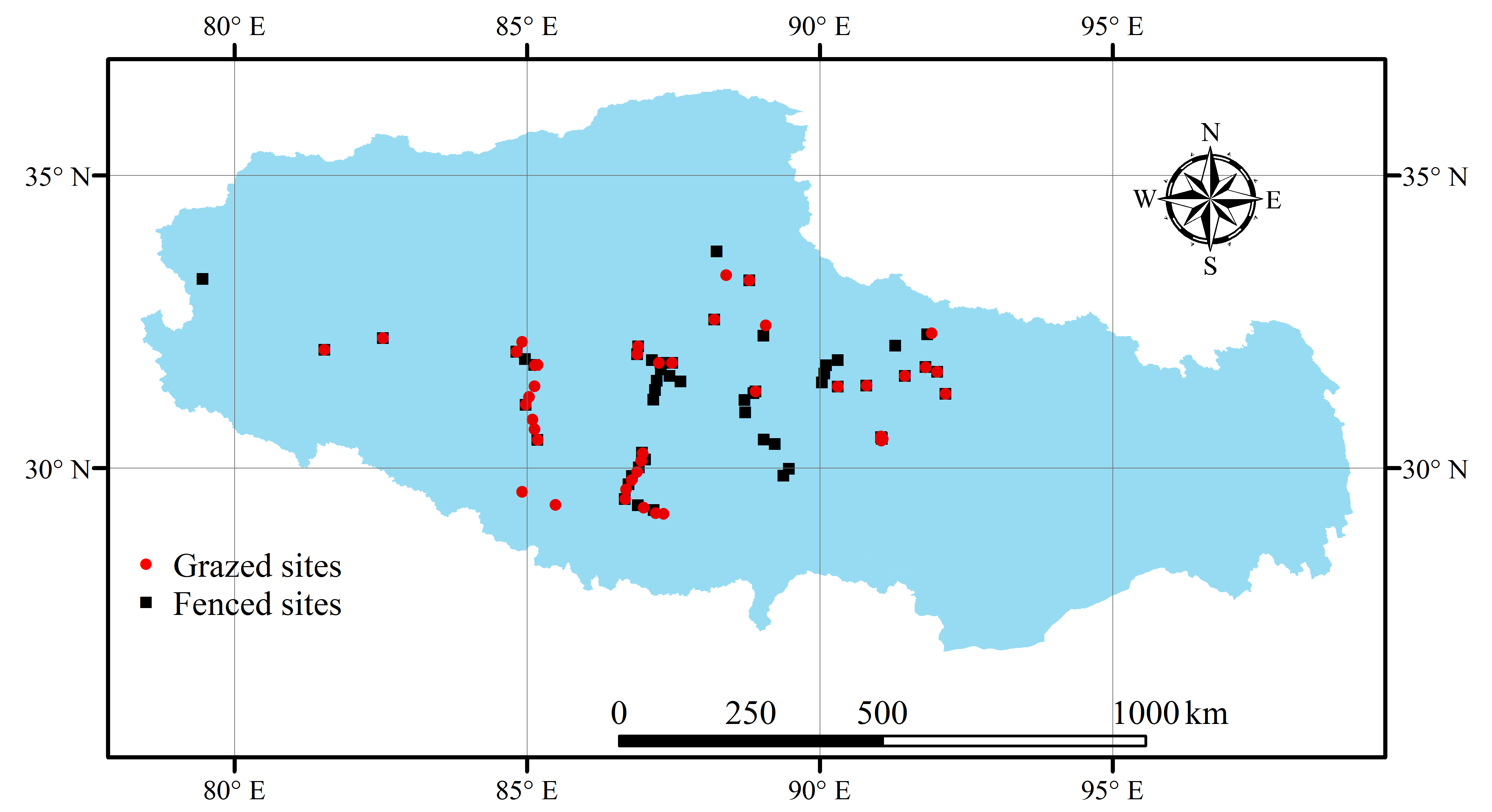
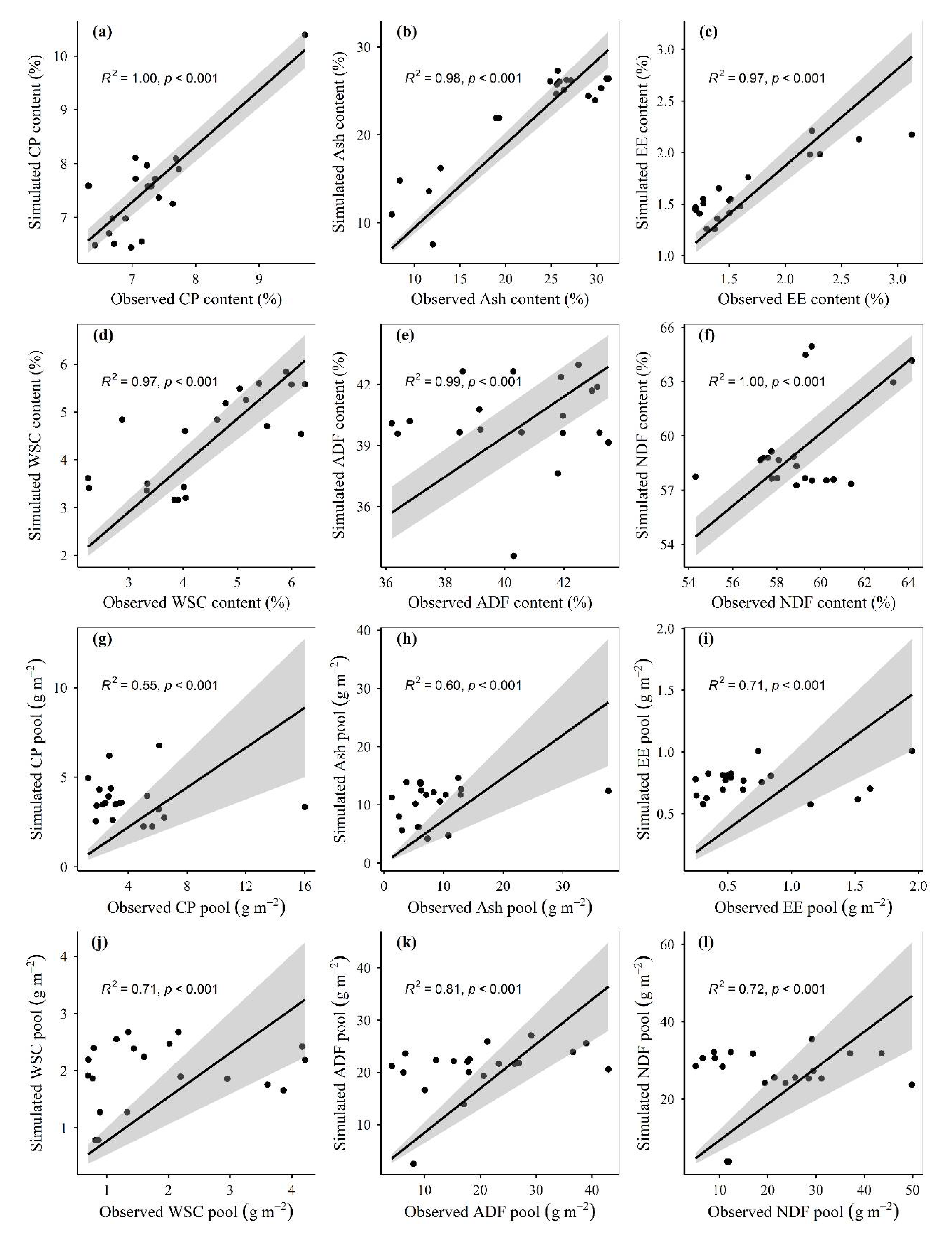
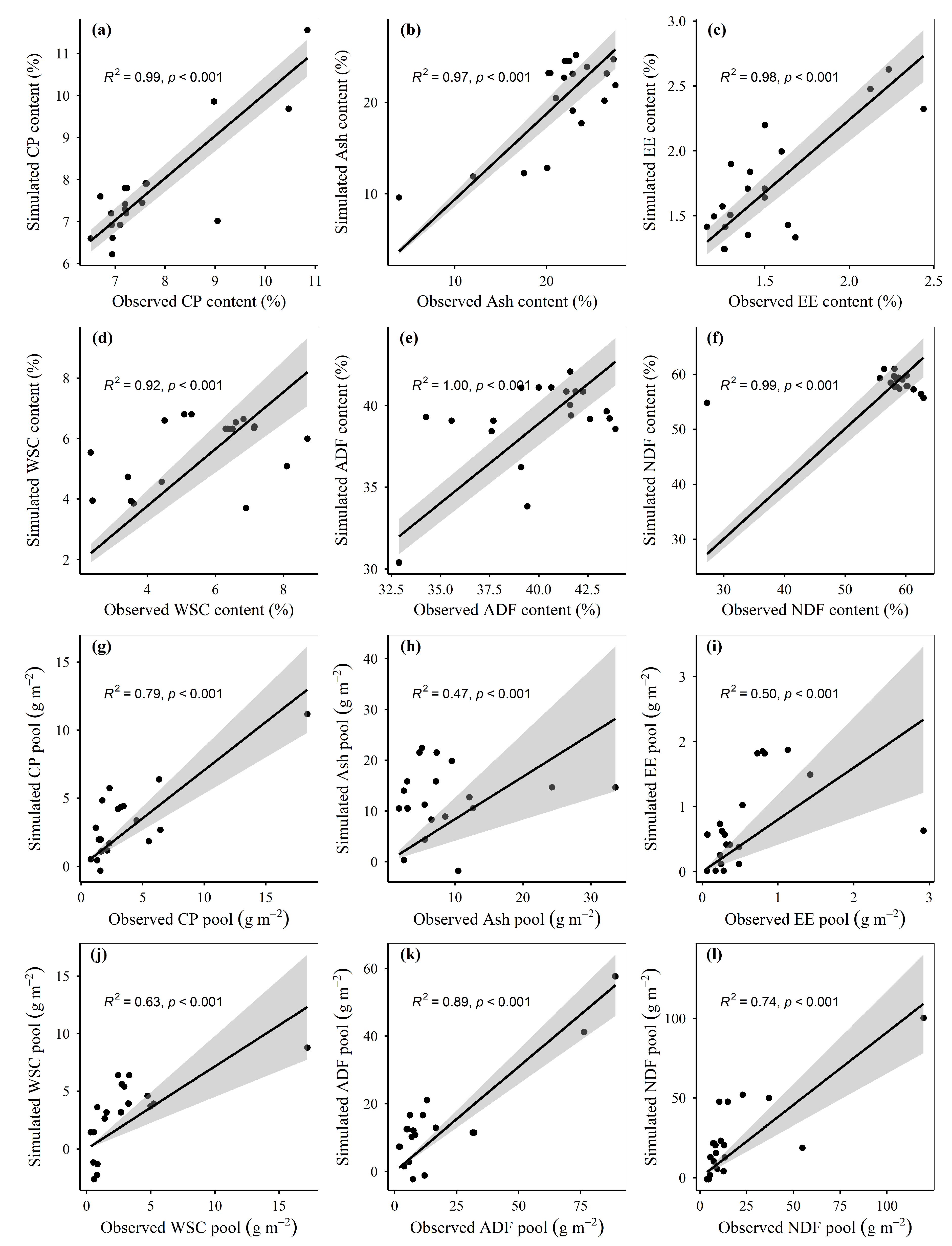


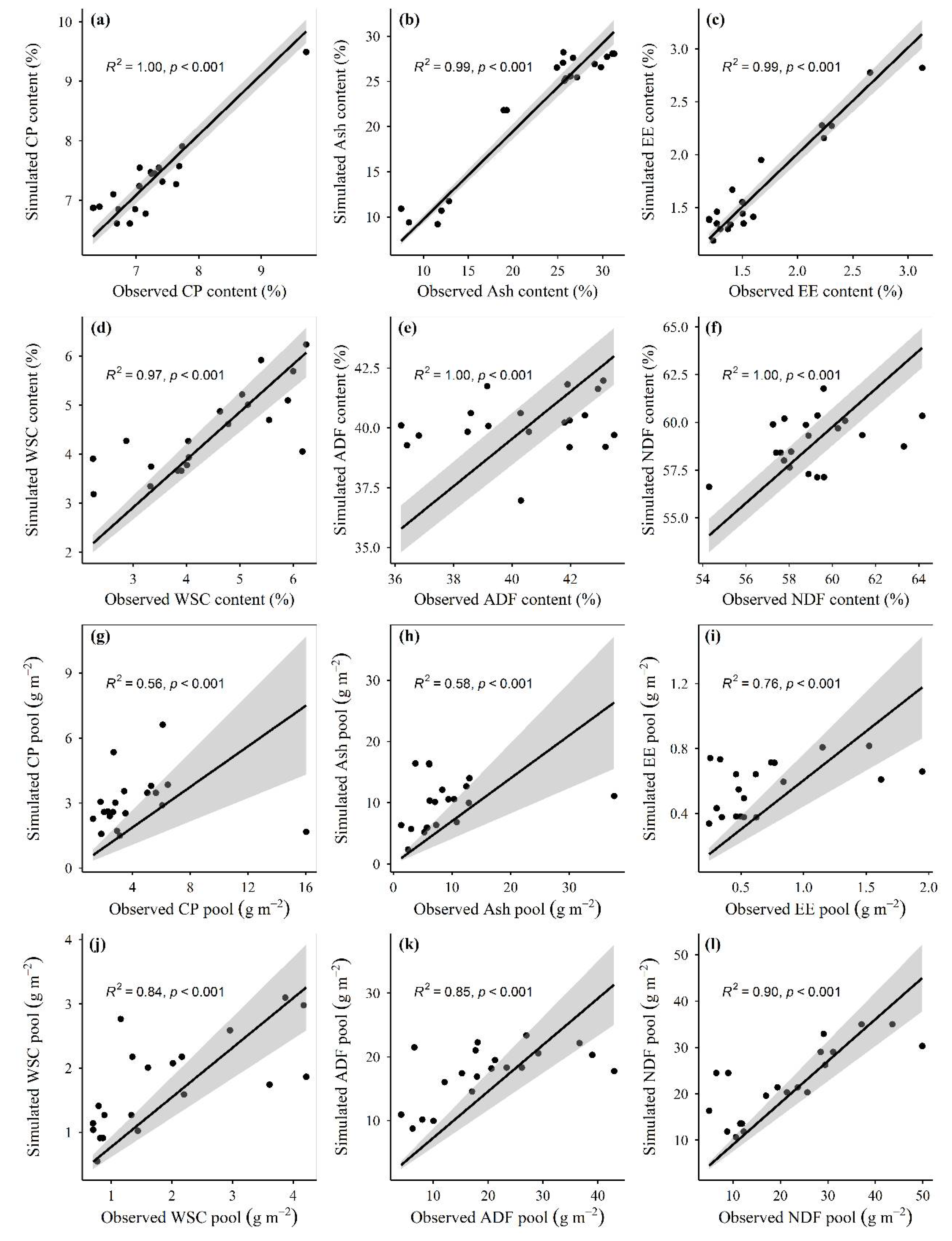
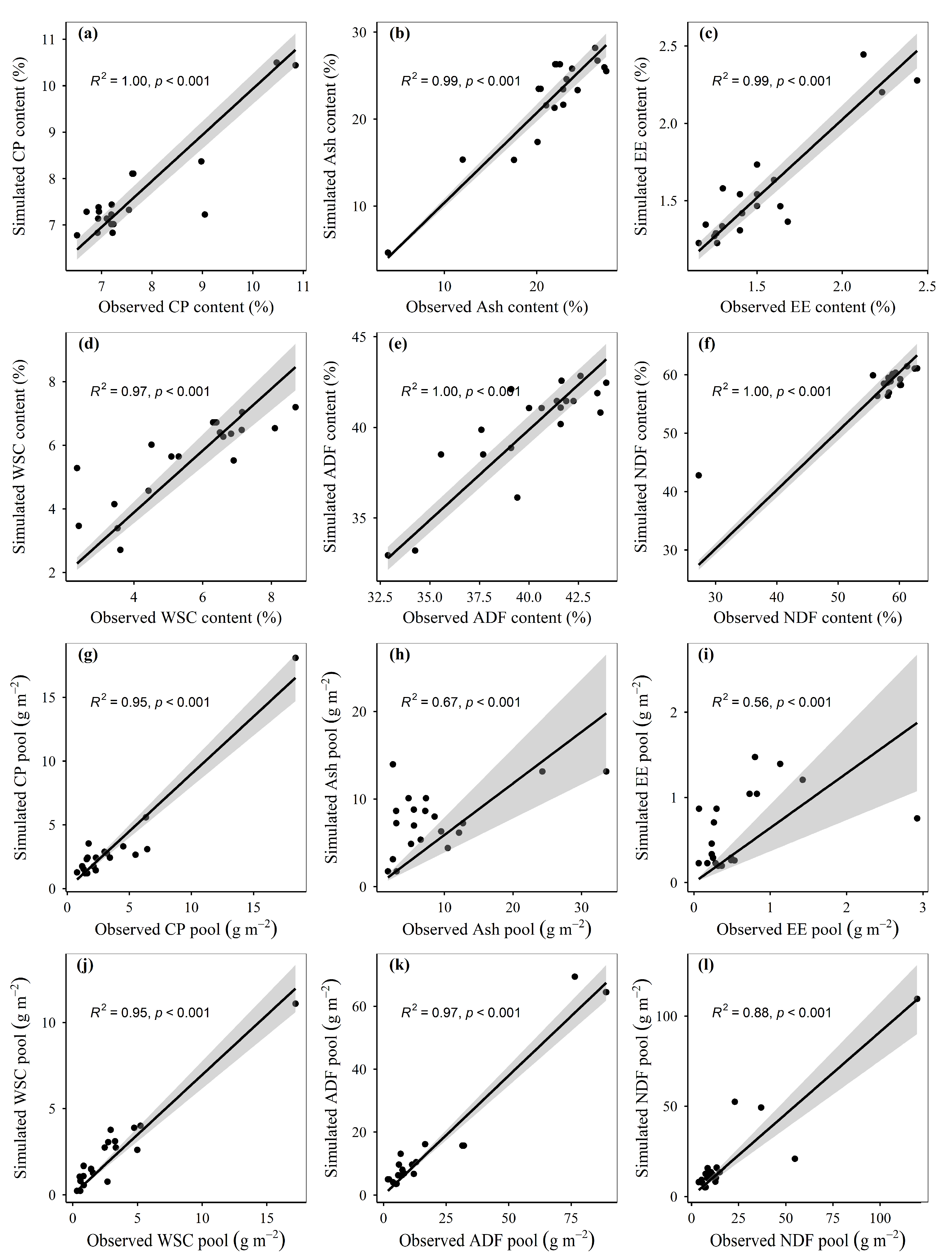

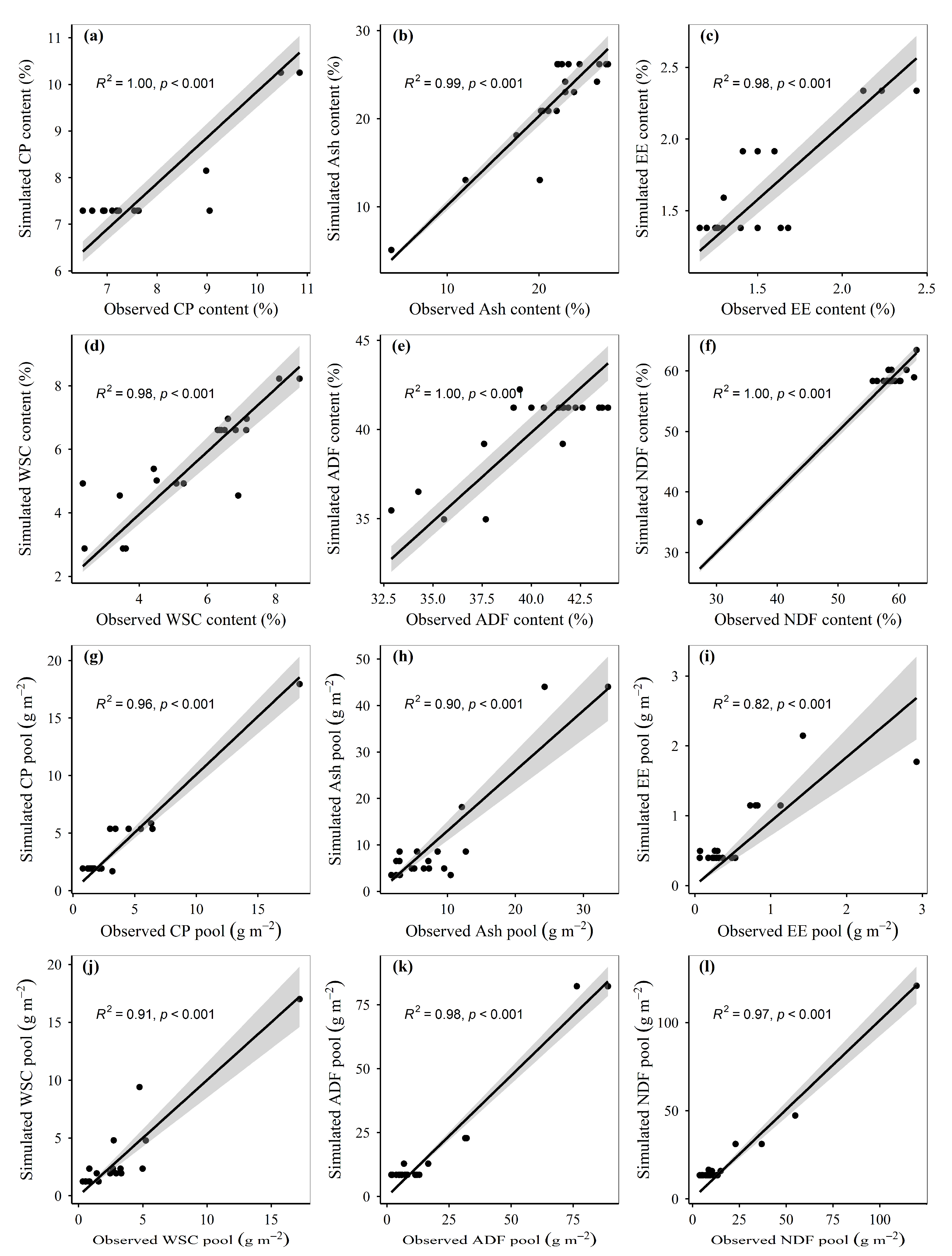
| Variables | Land-Use Types | Regression Coefficients | R2 | ||||
|---|---|---|---|---|---|---|---|
| Intercept | Temperature | Precipitation | Radiation | NDVI | |||
| ADF content | Fencing | −9.56 | −0.39 | 0.00 | 0.01 | 0.26 | |
| Grazing | −13.03 | 1.60 | 0.02 | 0.01 | −2.09 | 0.25 | |
| ADF pool | Fencing | −24.26 | 1.96 | 0.03 | 0.01 | 0.05 | |
| Grazing | −143.96 | 1.58 | 0.02 | 0.03 | 69.08 | 0.39 | |
| Ash content | Fencing | −55.08 | 0.80 | −0.01 | 0.02 | 0.70 | |
| Grazing | −35.98 | 1.33 | 0.01 | 0.01 | −11.00 | 0.42 | |
| Ash pool | Fencing | −49.26 | 0.67 | 0.01 | 0.01 | 0.20 | |
| Grazing | −129.79 | 1.18 | 0.00 | 0.03 | 43.03 | 0.28 | |
| CP content | Fencing | 36.37 | −0.02 | 0.00 | −0.01 | 0.75 | |
| Grazing | 42.75 | −0.59 | −0.01 | −0.01 | 1.12 | 0.57 | |
| CP pool | Fencing | 20.33 | 0.36 | 0.00 | −0.01 | 0.20 | |
| Grazing | −12.70 | 0.15 | 0.00 | 0.00 | 19.28 | 0.57 | |
| EE content | Fencing | 7.47 | −0.02 | 0.00 | 0.00 | 0.57 | |
| Grazing | 8.02 | −0.19 | 0.00 | 0.00 | −0.48 | 0.50 | |
| EE pool | Fencing | 2.95 | 0.06 | 0.00 | 0.00 | 0.06 | |
| Grazing | −2.25 | 0.00 | 0.00 | 0.00 | 3.98 | 0.44 | |
| NDF content | Fencing | 88.26 | −0.20 | 0.01 | −0.01 | 0.25 | |
| Grazing | 33.80 | 0.62 | 0.02 | 0.00 | −9.44 | 0.08 | |
| NDF pool | Fencing | 7.60 | 2.29 | 0.05 | −0.01 | 0.11 | |
| Grazing | −257.39 | 2.45 | 0.03 | 0.06 | 121.09 | 0.49 | |
| WSC content | Fencing | −2.44 | 0.18 | 0.00 | 0.00 | 0.35 | |
| Grazing | −12.70 | 0.18 | 0.00 | 0.00 | 2.82 | 0.28 | |
| WSC pool | Fencing | −4.36 | 0.19 | 0.00 | 0.00 | 0.09 | |
| Grazing | −36.28 | 0.43 | 0.00 | 0.01 | 20.99 | 0.41 | |
| Variables | Land-Use Types | R2 | Mean Square Errors | ntree | mtry |
|---|---|---|---|---|---|
| ADF content | Fencing | 0.82 | 3.82 | 773 | 3 |
| Grazing | 0.90 | 4.59 | 872 | 2 | |
| ADF pool | Fencing | 0.73 | 90.31 | 813 | 3 |
| Grazing | 0.91 | 27.89 | 897 | 4 | |
| Ash content | Fencing | 0.93 | 3.76 | 549 | 1 |
| Grazing | 0.94 | 3.09 | 887 | 4 | |
| Ash pool | Fencing | 0.78 | 13.79 | 786 | 1 |
| Grazing | 0.76 | 54.90 | 450 | 3 | |
| CP content | Fencing | 0.92 | 0.28 | 508 | 1 |
| Grazing | 0.93 | 0.40 | 788 | 1 | |
| CP pool | Fencing | 0.83 | 1.55 | 945 | 1 |
| Grazing | 0.93 | 1.29 | 340 | 3 | |
| EE content | Fencing | 0.80 | 0.04 | 501 | 2 |
| Grazing | 0.91 | 0.04 | 503 | 2 | |
| EE pool | Fencing | 0.79 | 0.08 | 331 | 2 |
| Grazing | 0.88 | 0.10 | 809 | 2 | |
| NDF content | Fencing | 0.86 | 3.19 | 824 | 3 |
| Grazing | 0.93 | 3.17 | 939 | 4 | |
| NDF pool | Fencing | 0.78 | 64.46 | 328 | 1 |
| Grazing | 0.94 | 51.90 | 755 | 4 | |
| WSC content | Fencing | 0.82 | 0.34 | 640 | 2 |
| Grazing | 0.96 | 0.23 | 850 | 4 | |
| WSC pool | Fencing | 0.77 | 0.65 | 215 | 1 |
| Grazing | 0.87 | 4.14 | 622 | 3 |
| Variables | Land-Use Types | Mean Residuals | Mean Decision Values | No of Support Vectors |
|---|---|---|---|---|
| ADF content | Fencing | −0.06 | 0.01 | 145 |
| Grazing | −0.32 | 0.05 | 144 | |
| ADF pool | Fencing | 5.01 | −0.27 | 173 |
| Grazing | 1.21 | −0.07 | 127 | |
| Ash content | Fencing | −0.20 | 0.03 | 138 |
| Grazing | −0.16 | 0.02 | 138 | |
| Ash pool | Fencing | 1.20 | −0.15 | 140 |
| Grazing | 2.88 | −0.19 | 162 | |
| CP content | Fencing | 0.08 | −0.04 | 126 |
| Grazing | 0.16 | −0.07 | 129 | |
| CP pool | Fencing | 0.50 | −0.17 | 138 |
| Grazing | 0.21 | −0.05 | 120 | |
| EE content | Fencing | 0.03 | −0.07 | 143 |
| Grazing | 0.01 | −0.02 | 131 | |
| EE pool | Fencing | 0.15 | −0.24 | 145 |
| Grazing | 0.13 | −0.14 | 143 | |
| NDF content | Fencing | 0.19 | −0.04 | 150 |
| Grazing | −0.22 | 0.03 | 131 | |
| NDF pool | Fencing | 3.20 | −0.19 | 145 |
| Grazing | 1.88 | −0.07 | 120 | |
| WSC content | Fencing | −0.04 | 0.03 | 155 |
| Grazing | 0.11 | −0.05 | 144 | |
| WSC pool | Fencing | 0.30 | −0.18 | 150 |
| Grazing | 0.71 | −0.13 | 137 |
| Variables | Land-Use Types | R2 | Minsplit | Minbucket | Maxcompete | Maxsurrogate | Usesurrogate | Surrogatestyle | Maxdepth | xval |
|---|---|---|---|---|---|---|---|---|---|---|
| ADF content | Fencing | 0.60 | 20 | 7 | 4 | 5 | 2 | 0 | 30 | 10 |
| Grazing | 0.84 | 20 | 7 | 4 | 5 | 2 | 0 | 30 | 10 | |
| ADF pool | Fencing | 0.24 | 20 | 7 | 4 | 5 | 2 | 0 | 30 | 10 |
| Grazing | 0.87 | 20 | 7 | 4 | 5 | 2 | 0 | 30 | 10 | |
| Ash content | Fencing | 0.88 | 20 | 7 | 4 | 5 | 2 | 0 | 30 | 10 |
| Grazing | 0.69 | 20 | 7 | 4 | 5 | 2 | 0 | 30 | 10 | |
| Ash pool | Fencing | 0.50 | 20 | 7 | 4 | 5 | 2 | 0 | 30 | 10 |
| Grazing | 0.55 | 20 | 7 | 4 | 5 | 2 | 0 | 30 | 10 | |
| CP content | Fencing | 0.92 | 20 | 7 | 4 | 5 | 2 | 0 | 30 | 10 |
| Grazing | 0.86 | 20 | 7 | 4 | 5 | 2 | 0 | 30 | 10 | |
| CP pool | Fencing | 0.37 | 20 | 7 | 4 | 5 | 2 | 0 | 30 | 10 |
| Grazing | 0.89 | 20 | 7 | 4 | 5 | 2 | 0 | 30 | 10 | |
| EE content | Fencing | 0.81 | 20 | 7 | 4 | 5 | 2 | 0 | 30 | 10 |
| Grazing | 0.84 | 20 | 7 | 4 | 5 | 2 | 0 | 30 | 10 | |
| EE pool | Fencing | 0.32 | 20 | 7 | 4 | 5 | 2 | 0 | 30 | 10 |
| Grazing | 0.77 | 20 | 7 | 4 | 5 | 2 | 0 | 30 | 10 | |
| NDF content | Fencing | 0.73 | 20 | 7 | 4 | 5 | 2 | 0 | 30 | 10 |
| Grazing | 0.42 | 20 | 7 | 4 | 5 | 2 | 0 | 30 | 10 | |
| NDF pool | Fencing | 0.45 | 20 | 7 | 4 | 5 | 2 | 0 | 30 | 10 |
| Grazing | 0.91 | 20 | 7 | 4 | 5 | 2 | 0 | 30 | 10 | |
| WSC content | Fencing | 0.65 | 20 | 7 | 4 | 5 | 2 | 0 | 30 | 10 |
| Grazing | 0.54 | 20 | 7 | 4 | 5 | 2 | 0 | 30 | 10 | |
| WSC pool | Fencing | 0.36 | 20 | 7 | 4 | 5 | 2 | 0 | 30 | 10 |
| Grazing | 0.66 | 20 | 7 | 4 | 5 | 2 | 0 | 30 | 10 |
| Variables | Fencing | Grazing | ||||||
|---|---|---|---|---|---|---|---|---|
| Multiple Linear Regression | Random Forest | Support-Vector Machines | Recursive-Regression Trees | Multiple Linear Regression | Random Forest | Support-Vector Machines | Recursive-Regression Trees | |
| CP content | 0.60 | 0.13 | 0.32 | 0.40 | 0.66 | 0.19 | 0.53 | 0.55 |
| CP pool | 3.50 | 0.94 | 3.52 | 2.47 | 2.41 | 0.55 | 1.20 | 1.07 |
| Ash content | 3.47 | 0.86 | 2.18 | 2.47 | 3.80 | 0.46 | 2.39 | 2.49 |
| Ash pool | 7.58 | 2.37 | 7.67 | 8.31 | 10.24 | 2.99 | 6.68 | 5.97 |
| EE content | 0.30 | 0.12 | 0.16 | 0.17 | 0.33 | 0.07 | 0.15 | 0.22 |
| EE pool | 0.47 | 0.11 | 0.44 | 0.45 | 0.72 | 0.15 | 0.59 | 0.38 |
| WSC content | 0.84 | 0.32 | 0.79 | 0.61 | 1.61 | 0.33 | 1.04 | 0.92 |
| WSC pool | 1.22 | 0.32 | 0.89 | 0.84 | 2.88 | 0.50 | 1.61 | 1.46 |
| ADF content | 3.06 | 0.99 | 2.34 | 1.52 | 2.97 | 0.93 | 1.63 | 1.85 |
| ADF pool | 9.93 | 3.72 | 9.25 | 9.66 | 15.37 | 2.75 | 9.69 | 5.11 |
| NDF content | 2.43 | 0.61 | 2.01 | 1.47 | 6.80 | 0.74 | 3.77 | 2.26 |
| NDF pool | 14.45 | 4.50 | 7.88 | 5.83 | 17.55 | 2.80 | 11.09 | 5.93 |
| Variables | Fencing | Grazing | ||||||
|---|---|---|---|---|---|---|---|---|
| Multiple Linear Regression | Random Forest | Support-Vector Machines | Recursive-Regression Trees | Multiple Linear Regression | Random Forest | Support-Vector Machines | Recursive-Regression Trees | |
| CP content | 8.36 | 1.81 | 4.46 | 5.57 | 8.58 | 2.47 | 6.89 | 7.15 |
| CP pool | 84.07 | 22.58 | 84.55 | 59.33 | 67.16 | 15.33 | 33.44 | 29.82 |
| Ash content | 15.41 | 3.82 | 9.68 | 10.97 | 17.74 | 2.15 | 11.16 | 11.63 |
| Ash pool | 86.63 | 27.08 | 87.65 | 94.97 | 120.96 | 35.32 | 78.91 | 70.52 |
| EE content | 18.08 | 7.23 | 9.64 | 10.24 | 21.70 | 4.60 | 9.86 | 14.47 |
| EE pool | 65.91 | 15.43 | 61.71 | 63.11 | 121.12 | 25.23 | 99.25 | 63.92 |
| WSC content | 18.93 | 7.21 | 17.81 | 13.75 | 28.86 | 5.92 | 18.64 | 16.49 |
| WSC pool | 64.91 | 17.03 | 47.35 | 44.69 | 99.94 | 17.35 | 55.87 | 50.67 |
| ADF content | 7.55 | 2.44 | 5.77 | 3.75 | 7.42 | 2.32 | 4.07 | 4.62 |
| ADF pool | 49.77 | 18.65 | 46.36 | 48.42 | 71.36 | 12.77 | 44.99 | 23.72 |
| NDF content | 4.11 | 1.03 | 3.40 | 2.49 | 11.83 | 1.29 | 6.56 | 3.93 |
| NDF pool | 66.96 | 20.85 | 36.52 | 27.02 | 92.97 | 14.83 | 58.75 | 31.41 |
| Variables | Fencing | Grazing | ||||||
|---|---|---|---|---|---|---|---|---|
| Multiple Linear Regression | Random Forest | Support-Vector Machines | Recursive-Regression Trees | Multiple Linear Regression | Random Forest | Support-Vector Machines | Recursive-Regression Trees | |
| CP content | 4.16 | 0.71 | 1.48 | 1.33 | 0.63 | 0.90 | −0.20 | −0.82 |
| CP pool | −10.52 | 4.65 | −27.32 | −2.04 | −9.95 | 0.25 | −10.02 | 10.00 |
| Ash content | −2.11 | −0.78 | −1.46 | 0.02 | −4.57 | 0.91 | 4.31 | 2.02 |
| Ash pool | 18.86 | 3.44 | 11.62 | 23.37 | 45.75 | 4.38 | −11.59 | 22.45 |
| EE content | −1.79 | −0.96 | 1.71 | −0.75 | 13.16 | 1.23 | 1.79 | 6.14 |
| EE pool | 5.76 | −5.56 | −20.20 | 4.24 | 24.20 | 5.48 | 3.68 | 20.84 |
| WSC content | 0.23 | −1.78 | 0.52 | −5.16 | 1.10 | −0.18 | 1.13 | 1.19 |
| WSC pool | 4.48 | −1.02 | −7.99 | 3.55 | −6.05 | −1.44 | −18.71 | 9.19 |
| ADF content | −1.11 | −0.06 | −0.87 | −0.68 | −2.47 | −0.68 | −0.20 | −0.20 |
| ADF pool | 3.92 | 0.80 | −12.79 | 4.63 | −25.55 | −2.26 | −20.12 | −0.57 |
| NDF content | 0.28 | 0.51 | −0.30 | 0.16 | 1.62 | −0.32 | 1.43 | 0.48 |
| NDF pool | 21.04 | 0.83 | 3.71 | −2.23 | 28.43 | 2.65 | 5.52 | 19.89 |
| Variables | Fencing | Grazing | ||||||
|---|---|---|---|---|---|---|---|---|
| Multiple Linear Regression | Random Forest | Support-Vector Machines | Recursive-Regression Trees | Multiple Linear Regression | Random Forest | Support-Vector Machines | Recursive-Regression Trees | |
| CP content | 1.04 | 1.01 | 1.01 | 1.01 | 1.00 | 1.01 | 0.99 | 0.98 |
| CP pool | 0.55 | 1.02 | 0.47 | 0.77 | 0.71 | 0.99 | 0.90 | 1.01 |
| Ash content | 0.95 | 0.99 | 0.97 | 0.99 | 0.94 | 1.01 | 1.04 | 1.02 |
| Ash pool | 0.73 | 0.94 | 0.70 | 0.79 | 0.84 | 0.98 | 0.59 | 1.30 |
| EE content | 0.94 | 0.99 | 1.00 | 0.98 | 1.12 | 1.01 | 1.01 | 1.05 |
| EE pool | 0.75 | 0.95 | 0.60 | 0.86 | 0.80 | 1.00 | 0.64 | 0.92 |
| WSC content | 0.97 | 0.98 | 0.97 | 0.94 | 0.94 | 0.99 | 0.97 | 0.99 |
| WSC pool | 0.77 | 0.97 | 0.77 | 0.91 | 0.72 | 1.00 | 0.70 | 1.00 |
| ADF content | 0.99 | 1.00 | 0.99 | 0.99 | 0.97 | 0.99 | 1.00 | 1.00 |
| ADF pool | 0.81 | 0.97 | 0.73 | 0.92 | 0.62 | 0.98 | 0.76 | 0.95 |
| NDF content | 1.00 | 1.00 | 1.00 | 1.00 | 1.00 | 1.00 | 1.00 | 1.00 |
| NDF pool | 0.94 | 0.99 | 0.90 | 0.94 | 0.91 | 1.00 | 0.91 | 1.01 |
Publisher’s Note: MDPI stays neutral with regard to jurisdictional claims in published maps and institutional affiliations. |
© 2022 by the authors. Licensee MDPI, Basel, Switzerland. This article is an open access article distributed under the terms and conditions of the Creative Commons Attribution (CC BY) license (https://creativecommons.org/licenses/by/4.0/).
Share and Cite
Han, F.; Fu, G.; Yu, C.; Wang, S. Modeling Nutrition Quality and Storage of Forage Using Climate Data and Normalized-Difference Vegetation Index in Alpine Grasslands. Remote Sens. 2022, 14, 3410. https://doi.org/10.3390/rs14143410
Han F, Fu G, Yu C, Wang S. Modeling Nutrition Quality and Storage of Forage Using Climate Data and Normalized-Difference Vegetation Index in Alpine Grasslands. Remote Sensing. 2022; 14(14):3410. https://doi.org/10.3390/rs14143410
Chicago/Turabian StyleHan, Fusong, Gang Fu, Chengqun Yu, and Shaohua Wang. 2022. "Modeling Nutrition Quality and Storage of Forage Using Climate Data and Normalized-Difference Vegetation Index in Alpine Grasslands" Remote Sensing 14, no. 14: 3410. https://doi.org/10.3390/rs14143410






